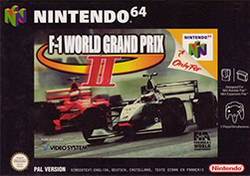This article needs additional citations for verification .(December 2009) |
| F-1 World Grand Prix II | |
|---|---|
 European Nintendo 64 cover art | |
| Developers | Paradigm Entertainment (N64) Video System (GBC, DC) |
| Publisher | Video System |
| Series | F1 Grand Prix |
| Platforms | Nintendo 64, Game Boy Color, Dreamcast |
| Release | Nintendo 64
Dreamcast |
| Genre | Sim racing |
| Modes | Single-player, multiplayer |
F-1 World Grand Prix II is a Formula One racing game for the Nintendo 64, Sega Dreamcast and Game Boy Color. The Nintendo 64 version was released only in Europe in 1999, [2] with other formats following in 2000. The game is a sequel to F-1 World Grand Prix , and is based on the 1998 Formula One season (Nintendo 64 version) and the 1999 Formula One season (Game Boy Color and Dreamcast versions).